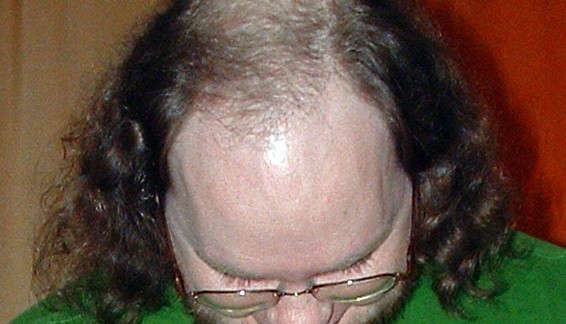Medications
Treatments for the various forms of hair loss have limited success. Three medications have evidence to support their use in male pattern hair loss: finasteride, dutasteride and minoxidil. They typically work better to prevent further hair loss than to regrow lost hair.
- Minoxidil (Rogaine) is a nonprescription medication approved for male pattern baldness and alopecia areata. In a liquid or foam, it is rubbed into the scalp twice a day. Some people have an allergic reaction to the propylene glycol in the minoxidil solution and a minoxidil foam was developed without propylene glycol. Not all users will regrow hair. The longer the hair has stopped growing, the less likely minoxidil will regrow hair. Minoxidil is not effective for other causes of hair loss. Hair regrowth can take 1 to 6 months to begin. Treatment must be continued indefinitely. If the treatment is stopped, hair loss resumes. Any regrown hair and any hair susceptible to being lost, while Minoxidil was used, will be lost. Most frequent side effects are mild scalp irritation, allergic contact dermatitis, and unwanted hair in other parts of the body.
- Finasteride (Propecia) is used in male-pattern hair loss in a pill form, taken 1 milligram per day. It is not indicated for women and is not recommended in pregnant women. Treatment is effective starting within 6 weeks of treatment. Finasteride causes an increase in hair retention, the weight of hair, and some increase in regrowth. Side effects in about 2% of males, include decreased sex drive, erectile dysfunction, and ejaculatory dysfunction. Treatment should be continued as long as positive results occur. Once treatment is stopped, hair loss resumes.
- Corticosteroids injections into the scalp can be used to treat alopecia areata. This type of treatment is repeated on a monthly basis. Oral pills for extensive hair loss may be used for alopecia areata. Results may take up to a month to be seen.
- Immunosuppressants applied to the scalp have been shown to temporarily reverse alopecia areata, though the side effects of some of these drugs make such therapy questionable.
- There is some tentative evidence that anthralin maybe useful alopecia areata.
- Hormonal modulators (oral contraceptives or antiandrogens such as spironolactone and flutamide) can be used for female-pattern hair loss associated with hyperandrogenemia.
Surgery
Hair transplantation is usually carried out under local anaesthetic. A surgeon will move healthy hair from the back and sides of the head to areas of thinning. The procedure can take between four and eight hours, and additional sessions can be carried out to make hair even thicker. Transplanted hair falls out within a few weeks, but regrows permanently within months. Hair transplants, takes tiny plugs of skin, each which contains a few hairs, and implants the plugs into bald sections. The plugs are generally taken from the back or sides of the scalp. Several transplant sessions may be necessary.
- Surgical options, such as follicle transplants, scalp flaps, and hair loss reduction, are available. These procedures are generally chosen by those who are self-conscious about their hair loss, but they are expensive and painful, with a risk of infection and scarring. Once surgery has occurred, six to eight months are needed before the quality of new hair can be assessed.
- Scalp reduction is the process is the decreasing of the area of bald skin on the head. In time, the skin on the head becomes flexible and stretched enough that some of it can be surgically removed. After the hairless scalp is removed, the space is closed with hair-covered scalp. Scalp reduction is generally done in combination with hair transplantation to provide a natural-looking hairline, especially those with extensive hair loss.
- Hairline lowering can sometimes be used to lower a high hairline secondary to hair loss, although there may be a visible scar after further hair loss.
- Wigs are an alternative to medical and surgical treatment; some patients wear a wig or hairpiece. They can be used permanently or temporarily to cover the hair loss. High-quality, natural-looking wigs and hairpieces are available.
Hiding hair loss

Head
One method of hiding hair loss is the “comb over”, which involves restyling the remaining hair to cover the balding area. It is usually a temporary solution, useful only while the area of hair loss is small. As the hair loss increases, a comb over becomes less effective.
Another method is to wear a hat or a hairpiece—a wig or toupee. The wig is a layer of artificial or natural hair made to resemble a typical hair style. In most cases the hair is artificial. Wigs vary widely in quality and cost. In the United States, the best wigs—those that look like real hair—cost up to tens of thousands of dollars. Organizations also collect individuals’ donations of their own natural hair to be made into wigs for young cancer patients who have lost their hair due to chemotherapy or other cancer treatment in addition to any type of hair loss.
Eyebrows
Though not as common as the loss of hair on the head, chemotherapy, hormone imbalance, forms of hair loss, and other factors can also cause loss of hair in the eyebrows. Loss of growth in the outer one third of the eyebrow is often associated with hypothyroidism. Artificial eyebrows are available to replace missing eyebrows or to cover patchy eyebrows. Eyebrow embroidery is another option which involves the use of a blade to add pigment to the eyebrows. This gives a natural 3D look for those who are worried about an artificial look and it lasts for two years. Micropigmentation (permanent makeup tattooing) is also available for those who want the look to be permanent.
Chemotherapy
Hypothermia caps may be useful to prevent hair loss during some kinds of chemotherapy, specifically when tazanes or anthracyclines are used. It should not be used when cancer is present in the skin of the scalp or for lymphoma or leukemia. There are generally only minor side effects from treatment.
Embracing baldness
Instead of concealing hair loss, some may embrace it by shaving their head. A shaved head will grow stubble in the same manner and at the same rate as a shaved face. The general public has become accepting of the shaved head as well, though female baldness can be considered less socially acceptable in various parts of the world.
Alternative medicine
Dietary supplements are not typically recommended. There is only one small trial of saw palmetto which shows tentative benefit in those with mild to moderate androgenetic alopecia. There is no evidence for biotin. Evidence for most other produces is also insufficient. There was no good evidence for gingko, aloe vera,ginseng, bergamot, hibiscus, or sorphora as of 2011.
Many people use unproven treatments. Egg oil, in Indian, Japanese, Unani (Roghan Baiza Murgh) and Chinese traditional medicine, was traditionally used as a treatment for hair loss.
